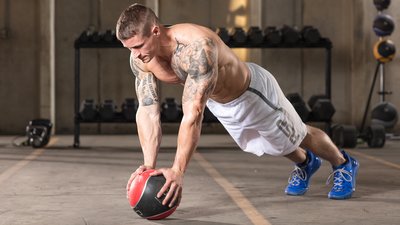New Year's is a holiday of excesses. Many of us eat too much, drink too much, and in the hangover haze that follows, resolve to achieve all our self-improvement goals in one fell swoop that begins with turning a page of the calendar.
Of course, January has other plans. From the lofty heights of "I resolve to eat healthy," "I resolve to lose weight," and "I resolve to go to the gym regularly," we suddenly find ourselves backsliding, unable to maintain our motivation and progress.
Such failures aren't necessarily an indictment of you or your willpower. Often, they result from taking on an overly ambitious and poorly defined goal, and then losing steam when you realize success can't be achieved overnight.
The fix is simple. We've tabbed two elite trainers, RSP Nutrition athletes Kieon Dorsey and Curtis Bartlett, to help you revise your resolutions and make them stronger and 100-percent attainable in 2017.
Here are some examples of how you can set more specific targets to lose fat, gain muscle, eat right, or get fit starting now.
Old resolution: "I resolve to lose body fat."
New resolution: "I resolve to do 30 minutes of cardio four days per week."
Losing weight involves a number of daily decisions and commitments—it's definitely not a case of changing just one thing. You need to attack it from multiple directions:
- Resistance training, to build more muscle, which not only burns calories during activity but upshifts your daily metabolism
- High-intensity interval training (HIIT), to gobble up additional calories during the activity and for hours afterward
- Dietary change, substituting clean foods that are high in nutrients in place of processed foods high in empty calories like refined sugars
- Recovery time, which is essential for muscle growth and ensuring you're physically at your best every time you step into the gym
With that in mind, a weight-loss goal should be broken down into numerous smaller pieces. One piece should build on the next, and they all should be easy to track and accomplish.

"Set a goal for the number of minutes you want to perform cardio—keep it on the conservative side when first starting out—or the distance that you'd like to cover on a given number of days," suggests Dorsey, a master trainer and fitness director at Sportscenter Athletic Club in High Point, North Carolina. "Now you have a target you can consistently and repetitively hit; this will get you started. From there, consistently try to exceed that goal. Remember, if it doesn't challenge you, it won't change you."
That could mean 30 minutes of cardio at 6 a.m. four days per week if you're a beginner trying to forge a habit, or running one mile in less than 10 minutes five days a week. For a more aggressive and specific goal, work up to 25 minutes of HIIT cardio twice a week combined with two more steady-state sessions.
With intervals, alternate 15 seconds of all-out exertion with 45 seconds at a low-intensity recovery pace (15/45) for three weeks. Then, increase the work time while reducing the rest to 20/40 for three weeks, then 25/35 for another three weeks, finally working up to intervals of 30/30.
Old resolution: "I resolve to eat healthy."
New resolution: "I resolve to eat 300-700 fewer calories each day than I consume"
Saying you're going to "eat healthier" is so open-ended, it's nearly impossible to quantify. How exactly are you going to gauge your progress? As the old business adage goes, what gets measured gets managed, says Bartlett, founder of Police Fitness, an online training service.
"Rather than 'eating healthy,' try completely cutting out sodas, sugary treats, and processed foods. Using RSP's QuadraLean each day instead of coffee loaded with sugar and cream can also help aid your fat-loss efforts," he says. "Cutting out a few hundred calories here or there is key to reaching your daily target. You'll want to track those cuts so you can better monitor your progress."

A rough estimate of your daily macros and calories can be found using the Bodybuilding.com online macronutrient calculator. Whether you're looking to lose weight or make gains, it allows you to input several physical characteristics and your goal to better estimate your starting place.
Along the way, you must continually track your weight loss (same with weight gain, by the way). Weigh yourself at the same time almost every day (preferably first thing in the morning), and adjust your caloric intake and activity levels if you're not achieving a reasonable downward trend in your weight, which should be about 0.5-1.0 percent of your body weight each week. If you're losing weight too quickly or too slowly, make adjustments to maintain a healthy weight-loss target.
"Preparation is key," Dorsey asserts. "Failing to plan is planning to fail, as they say. Whenever you can, plan your meals ahead of time—you'll almost always make a better decision nutrition-wise than had you not."

Old resolution: "I resolve to get strong and/or huge, even though I'm neither right now."
New resolution: "I'll learn the fundamental lifting movements, and practice them multiple times a week, for three months."
An advanced lifter may have a specific goal—say, to increase strength on a given lift by 10 percent. For beginners, however, there are a few steps you need to learn before setting such specific strength-based goals. One step is to learn, and rehearse over and over again, proper movement patterns. These are the big ones:
- The squat pattern
- The hip-hinge pattern
- The horizontal push and pull patterns (examples: push-up or bench press, row)
- The vertical push and pull patterns (examples: military press, pull-up, or pull down)
As a beginner, your muscles aren't wired properly yet to move big loads safely. During the initial phase of a program, the adaptations you'll experience are largely neural, meaning your musculature learns to work in a coordinated manner.

Beginners can build strength using relatively light loads at first, even as high as 8-12 reps. That's light enough that you won't struggle to achieve just a rep or two, and you can focus more on engraining proper form. Engrain bad form now, and you'll be a ticking time bomb down the road.
So, how do you learn textbook form? Bodybuilding.com's Exercise Database is one useful resource. A qualified personal trainer can be a godsend as well. Here's one that not enough people do: Have a friend or workout partner record you on a smartphone, so you can compare your own technique to that in the database, or ask someone who knows their stuff for tips.
Cause and Effect
"It's about setting small, realistic, specific goals that will bring you closer to your ultimate, long-term aim," Dorsey says.
Resolutions, then, should be more about action than how you look or feel. "I recommend focusing on the activity—what you're doing each day, which hopefully will be something you enjoy—than the result," he continues. "If you plan right and do those activities consistently, your desired result will follow."
Take that wishy-washy resolution and make it concrete and achievable, something you can accomplish in three months. "Rather than 'getting lean,' try trimming 30 seconds off your 5K run time in the next two months," Bartlett suggests. "It could even be something like fitting into an old pair of jeans that are now a few sizes too small. A big part of staying motivated is seeing improvement with your own eyes."

